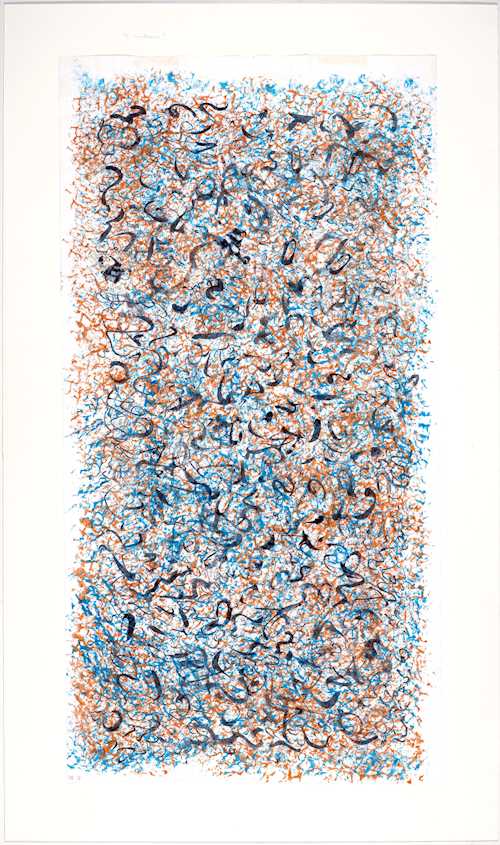
Lot 3415 - A191 PostWar & Contemporary - Saturday, 07. December 2019, 02.00 PM
MARK TOBEY
(Centerville 1890–1976 Basel)
Untitled. 1971.
Tempera sur papier parchemin.
Signed and dated lower left: Tobey 71.
102.5 x 53.5 cm.
Provenance:
- Galerie Alice Pauli, Lausanne (with the label on the reverse)
- Purchased by the present owner at the above in 2006, since then private collection Switzerland.
“The cult of space can become as dull as that of the object. The dimension that counts for the creative person is the Space he creates within himself. This inner space is closer to the infinite than the other, and it is the privilege of a balanced mind – and the search for an equilibrium is essential – to be as aware of inner space as he is of outer space. If he ventures in one, and neglects the other, man falls off his horse and the equilibrium is broken.” (Mark Tobey)
Mark Tobey’s pictorial world is complex and characterised by an almost inexhaustible potential for creativity, love of experimentation and power to innovate. The impressive materiality and stylistic diversity reveal and enable a broad range of themes, such as nature, civilization, cities, movements, sky and the cosmos, rhythm and music, emptiness and contemplation, free space, etc. He is inspired by his surroundings, where he seeks an abstraction, in which a profound, rhythmic plasticity is concealed.
“I like best to see in nature what I want in my painting. When we can find the abstract in nature, we find the deepest art.” (Mark Tobey). His pictorial body of work generates structures and constellations in the subconscious of the viewer and evokes an idea of representation, beyond the boundary between the abstract and the figurative, which is exemplified in the works offered here at auction. Whether it is fields dancing through the wind, or floating seeds, thanks to the finely worked style, the artist manages to invoke the organic in nature, through an association of ideas.
The early works from 1958 (Lot 3409) and from 1965 (Lot 3410) are distinct form the two other later works presented here, with their fine, fibrous, very dense and precise style. The work from 1958 is part of his series called „Meditation Writing“ and the work from 1965 is part of his series called "White Writings". The two later works from the 1970s are somewhat looser in style, the line is somewhat turbulent, wilder and freer. The choice of colours is rather more extravagant and yet they exude an unwavering harmony. The wonderful work from 1971 (Lot 3415), is a rather rare work due to its size and illustrates Tobey’s abstract expressionist style, constantly in the search for balance, which he mentions in the quote above.
Behind these works lies an extraordinary development – at the beginning of his career Mark Tobey moved to Chicago at the age of 16, where he attended courses in oil and watercolour painting at the Art Institute and earned his money as an industrial designer in a steelworks. In 1911 he moved to New York, where he worked as a portrait painter and fashion illustrator for Vogue magazine. During his time in New York Mark Tobey discovered and professed adherence to the spiritual teaching of Bahā'ullāh, who strove to create a union between the multifarious great world religions and find a common source of wisdom. He finally moved to Seattle, where he taught at the Cornish College of the Arts and became closely involved with Chinese painting. From 1925 he began to travel, staying in Paris and the Middle East, and with longer trips to China and Japan, where he studied Zen teaching and painting, as well as calligraphy, in a Zen monastery.
He also had a foothold in England, where between 1930 and 1938 he taught at the Dartington Hall School in Devonshire. In 1960 Tobey settled in Basel. In the same year the husband and wife collectors Ernst and Hildy Beyeler acquired 40 works from the artist. By then he already had an international reputation, had been awarded several prizes and had successfully participated in the Biennale and in Documenta II and III.
Mark Tobey would make each country where he spent any time into his homeland and is considered one of the few artists of the 20th century who lived a truly cosmopolitan life. He lived between cultures and worlds and in fact two exhibitions in 1989 at the Folkwang Museum in Essen and the Cantonal Museum in Mendrisio were entitled “Between Worlds”. He himself stated: “The art of the future cannot germinate in antagonism and nationalistic rivality but will spring forth with a renewed growth if man in general will grow to the stature of universal citizenship.” (quote: Mark Tobey in: Exh. Cat. Museo Nacional Centro de Arte Reina Sofia Madrid, 1997, p. 17).
In the course of his long involvement with calligraphy, he developed his own pictorial script; he never intended to imitate East Asian pictorial language, but rather to find his own personal style with a western influence. What is more, he never joined an artist group. “I have never tried to pursue a particular style in my work. From, the road has been a zigzag into and out of old civilisations, seeking for new horizons through meditation and contemplation.” (ibid p. 68). Mark Tobey lived out his universalism as a lone agent and left behind the patterns and traces of his life in his works.
CHF 40 000 / 60 000 | (€ 41 240 / 61 860)
Sold for CHF 49 100 (including buyer’s premium)
All information is subject to change.
